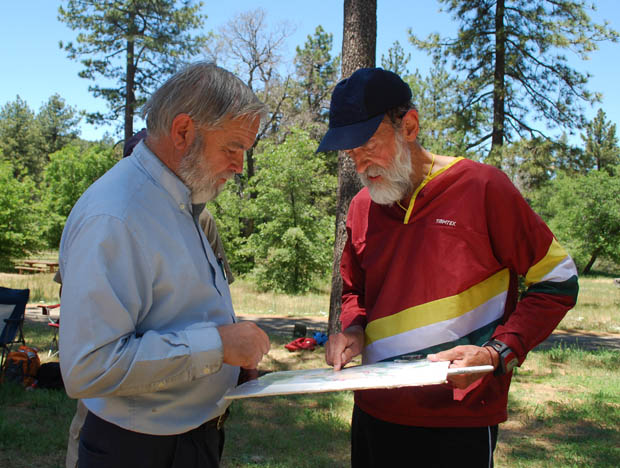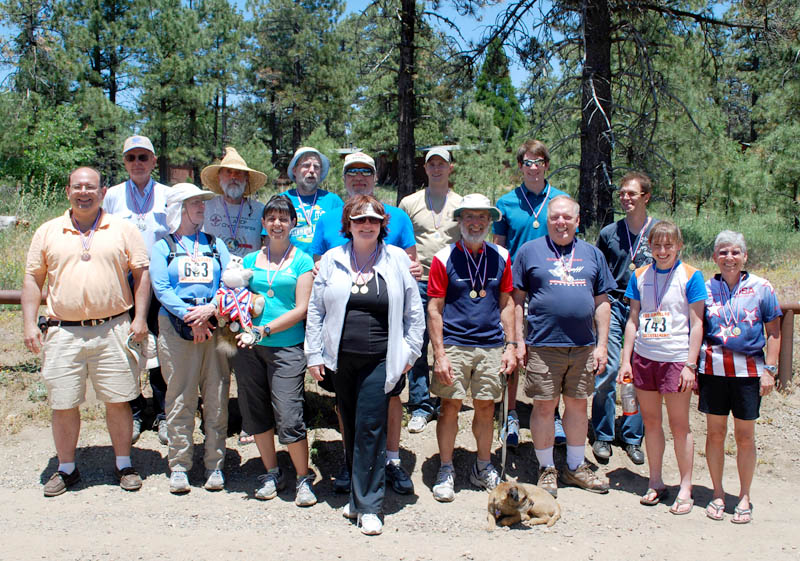The Twelfth USA National ARDF Championships
Mt. Laguna, California, June 1 - 3, 2012

Competitors on Saturday morning before the two-meter event.

Competitors on Saturday morning before the two-meter event.

 Mt. Laguna, California is a home town for 57 souls along Sunrise Highway in the Cleveland National Forest. You won't find a gas station or a doctor, but it has a nice restaurant (open three days a week), a general store, a lodge and several campgrounds that fill up in the winter with city folks who want to play in the snow. Normally, Mt. Laguna would be very quiet during the week and weekend after Memorial Day, but in 2012 its population nearly doubled as it hosted fans of radio direction finding (RDF) under international rules
Mt. Laguna, California is a home town for 57 souls along Sunrise Highway in the Cleveland National Forest. You won't find a gas station or a doctor, but it has a nice restaurant (open three days a week), a general store, a lodge and several campgrounds that fill up in the winter with city folks who want to play in the snow. Normally, Mt. Laguna would be very quiet during the week and weekend after Memorial Day, but in 2012 its population nearly doubled as it hosted fans of radio direction finding (RDF) under international rules
This is the third year that California has hosted the USA ARDF Championships, each time in well-mapped mountain forests. Mt. Pinos near Frazier Park was the first setting in 2004. Then in 2007, it was South Lake Tahoe in the Sierra Mountains. Headquarters for that was a family and children's camp in the El Dorado National Forest.
As an ARDF venue, Mt. Laguna is every bit as good. It is a 75-minute drive from downtown San Diego, but its climate is completely different from that seaside city. At 6000 feet elevation, the forests of Black Oaks and Jeffrey Pines are great for running in early June. Over 12,000 acres of the Cleveland National Forest around Mt. Laguna have been mapped for orienteering, making it possible to have separate locations for training, for competitions and for two new events.
 Los Angeles Orienteering Club was this year's primary sponsoring organization, with assistance from San Diego Orienteering and the mobile transmitter hunters of San Diego and Orange Counties. Marvin Johnston KE6HTS was General Chair of the organizers. A winner of medals in three previous national championships, Marvin also organized the two prior USA ARDF Championships in California.
Los Angeles Orienteering Club was this year's primary sponsoring organization, with assistance from San Diego Orienteering and the mobile transmitter hunters of San Diego and Orange Counties. Marvin Johnston KE6HTS was General Chair of the organizers. A winner of medals in three previous national championships, Marvin also organized the two prior USA ARDF Championships in California.
USA's national championships are open to all persons who can safely find their way through the forest for several kilometers while carrying direction-finding gear. There are no age limits. Four-fifths of the 2012 participants had Amateur Radio licenses and the rest were future hams. For a quarter of them, it was their first championship foxtailing event.
About half of the participants arrived Tuesday night or Wednesday morning for the optional "training camp." Most stayed in the rustic-but-comfortable cabins and motel units of Laguna Mountain Lodge. Wednesday's training event was a full-size ARDF course with two-meter AM transmitters.
So that training camp participants would not have an unfair advantage of familiarity later on, the training took place in a separate forest area from the championship competitions. Headquarters for training was Laguna Campground. Every effort was made to have the training courses be the same level of difficulty and follow the same procedures as the championship events to come. The biggest difference was that trainees were encouraged to find all five transmitters each day instead of just the three or four that those in most age/gender categories are required to find during the championships.
For Wednesday's 2m training, the shortest straight-line route was S-1-2-4-3-5-F, which was exactly 5.5 kilometers. However, those straight lines went through two trail-free areas of very heavy brush, which orienteers call "fight." The experienced hunters chose S-1-3-2-4-5-F, which avoided those dark green areas on their maps. That straight-line route distance was 6.6 kilometers. Due to other terrain obstacles, the actual distances traveled on that day were 7 kilometers or more.
For Wednesday's 2m training, the start was 3.6 miles northwest of Laguna Campground, just off Sunrise Highway. Trainees sought the transmitters as they worked their way back to the finish line at the campground. There they downloaded their "e-sticks" and received a printout with the exact times for their travels between each fox. Then they could discuss their route choices and get suggestions from experienced radio-orienteers about how to do it better next time.
First Tries at Foxoring
The sport of ARDF got its start on the 80-meter band. Two-meter competitions came along years later, but the tradition of 80-meter events at international championships continues. In preparation for that, Thursday's training was a full-size course with 80m CW transmitters in the same forest section as the two-meter training. Transmitter locations were different, of course, but almost everything else was the same. Afterwards, KE6HTS provided a hearty lunch of Santa Barbara style barbecued tri-tip beef and all the trimmings.
Plenty of hours of sunlight remained, so Marvin gave the trainees an introduction to an ARDF event that is new to the World Championships this year -- foxoring. It is a cross between orienteering and transmitter hunting that was developed in Europe to help get classic orienteers interested in radio-orienteering. It also helps ARDF enthusiasts to improve their orienteering skills.
Friday was opening day of the official USA championships and by evening, there were twice as many foxtailers present as there were during the training days. New arrivals checked their RDF gear using the test transmitters on both bands near the lodge in the early afternoon. Then it was time to try another new ARDF event -- the sprint.
The sprint competition was originally designed to be a demonstration for the public. At world championships, the sprint course has two loops with a spectator corridor between them. The first loop has five transmitters on one frequency. They are on for 12 seconds each in numbered sequence for a one-minute total cycle. This is five times faster than the rate of IARU standard competition transmitters. The second loop has five transmitters on another frequency, transmitting in sequence at the same fast rate.
Foxes, Snakes and Cougars
After the sprints and supper, everyone gathered in the lodge's meeting room for the pre-championships briefing. KE6HTS reviewed the rules and procedures for the two days of competition to come, then he presided over a random drawing that determined the starting order of the competitors.
April Moell WA6OPS gave a briefing on health and safety in the forest. Low humidity minimized concerns about ticks and poison oak, but made it important for everyone to stay hydrated. The greatest dangers would be rattlesnakes and mountain lions. "Rattlers rarely bite unless surprised or provoked," she said, "so just watch where you step."
"As far as mountain lions are concerned," April added, "the most important thing to remember is to not look like prey. A trail biker in our county was attacked a few years ago when he knelt down to tie his shoes. If you encounter one, stand tall, wave your arms and make a lot of noise. You can move back slowly, but don't try to run away because this big cat runs faster than you can."
Marvin designed the weekend competition courses to be difficult, on par with those at world championships. Straight-line course length was about 6.4 kilometers each day. Elevation of the finish was 300 feet higher than the start, with lots of hills and ravines between.

Volunteers drove all of the competitors and their gear to the starting point, which was four miles by road from the lodge. When they got their maps, they could see that the finish line would be at a trail junction just south of the lodge. Skies were partly cloudy with temperatures mostly in the 70's, making for good running conditions.
One two-meter transmitter did not come on at the appointed time, requiring a hike to it for repairs. That delayed Saturday's start by about 90 minutes. Once it was fixed and the hunt started, it was discovered that another of the transmitters had gone off the air, but it was decided to continue the hunt. Cause of the failures turned out to be AA batteries falling out of their holders while the transmitters were being handled and transported.
The transmitter problems plus signal reflections from the hills made it a tough day for many of the competitors. The most transmitters found by anyone on Saturday was three. Of those 3-fox finders, the best time (1:12:38) was posted by Nicolai Mejevoi, a former ARDF champion for the USSR and Moldava who now lives in Illinois. Second best time (1:34:12) was by Vadim Afonkin KB1RLI of Boston. Almost as fast (1:35:30) was 69-year-old Bob Cooley KF6VSE of Pleasanton, California.
The unluckiest competitor on Saturday had to be Grant Van Skiver VE7GVS of New Westminster, British Columbia. As he searched for his third transmitter in mid-course, a mountain lion ran across his path about thirty feet away. Grant remembered April's advice and began waving his antenna overhead as he made noise and slowly moved away from the direction where he had last seen the big cat. Suddenly, he no longer heard the fox signals in his Bluetooth earphone and he realized that his tiny Yaesu VX-3R transceiver had fallen off the antenna into the tall grass. Not wanting to suffer the fate of the Orange County biker who had been attacked as he bent down, Grant abandoned the radio and ended his foxtailing for the day.
Despite all of the problems on the 2m course, everyone was in a good mood Saturday evening during the feast of steak and chicken at Pine House Cafe. This traditional championships banquet normally includes the awarding of medals for that day's event, but results were not known by suppertime. Because of the delay in starting, some of the electronic scoring stations had automatically turned off during the hunt. The official results were later finalized using backup handwritten logs from the start, the finish and the field transmitter operators.
Murphy must have left town after his Saturday mischief, because Sunday's 80-meter championship hunt went off without a hitch. Since several participants had booked afternoon flights, the hunt started one hour earlier. Transmitters came on right on schedule and as expected, the lack of signal reflections meant that everyone did better hunting the HF signals. Whereas 2m times had been mostly between two and three hours, the majority of the 80m times were under two hours. Every 80m participant except one found all of the foxes required for his or her category. Medals were handed out at 1 PM and soon everyone was on the way home.
This year's medal recipients (in alphabetical order) were Vadim Afonkin KB1RLI (M40 gold on 80m and silver on 2m), Dick Arnett WB4SUV (M60 silver on 80m and bronze on 2m), Ruth Bromer WB4QZG (F60 gold on 80m and silver on 2m), Bob Cooley KF6VSE (M70 gold on both bands), Brian DeYoung K4BRI (M50 gold on 80m and bronze on 2m), Marji Garrett KJ4ZKC (F50 gold on both bands), Jay Hennigan WB6RDV (M60 gold on 80m and silver on 2m), Joseph Huberman K5JGH (M60 gold on 2m and bronze on 80m), Lori Huberman (F21 gold on both bands), Harley Leach KI7XF (M70 silver on both bands), Karla Leach KC7BLA (F60 gold on 2m and silver on 80m), Nicolai Mejevoi (M40 gold on 2m and silver on 80m), Alla Mezhevaya (F35 gold on both bands), Scott Moore KF6IKO (M50 silver on 2m and bronze on 80m), Matthew Robbins AA9YH (M40 bronze on both bands), Christine Sanders KE6BRY (F50 silver on 2m), Mike Schuh KF7QDZ (M50 gold on 2m and silver on 80m), Ian Smith (M21 gold on both bands) and Brad Weyers (M21 silver on 80m).
Congratulations to KE6HTS for pulling off a "three-peat," his third successful USA ARDF championships. Marvin's volunteer helpers deserve lots of thanks for making this foxhunting opportunity possible. They included Les Benson W6CGE, Joe Corones N6SZO, Tom Gaccione WB2LRH, Joe Loughlin KE6PHB and Gary Sanders KC6TWZ.
The archived official event Web page has the daily schedule, competition rules, transmitter and map details, lodging and transportation information. .
Four pages of photos are now in this Homing In site. Below are links to the official results.
Additional details are in my ARDF Update feature "Team USA Forming after USA ARDF Championships" on the ARRL Web site.
Portions of this report have been excerpted from my Homing In column in the Summer 2012 issue of CQ-VHF Magazine.
Joe Moell KØOV
Text and photos copyright © 2012 Joseph D. Moell. All rights reserved.
Go to Championships Foxhunting News -- Recent and upcoming ARDF championships events
Go to International-Style Foxhunting Comes To The Americas -- How we're getting the ball rolling
Go to Equipment Ideas for Radio-Orienteering -- Simple and inexpensive receiving and transmitting solutions
Go to Radio-Orienteering News for Southern California -- Results and stories of recent radio-orienteering events in southern California, plus announcements of upcoming ones.
Go to Foxhunting for Scouts -- Let's get the kids involved
This page updated 1 May 2013
Training camp results, Thursday, May 31
Foxoring results, Thursday, May 31
Sprint results, Friday, June 1
Two-meter event results, Saturday, June 2
Eighty-meter event results, Sunday, June 3
USA ARDF Coordinator

Most of the medal winners after the award ceremony on Sunday afternoon. Some had to leave earlier for home. (More photos) Go to First photo page of this event
Go to First photo page of this event Back to the Homing In home page
Back to the Homing In home page